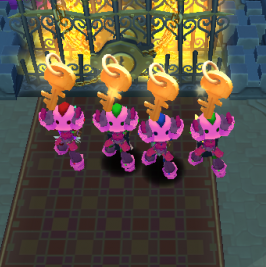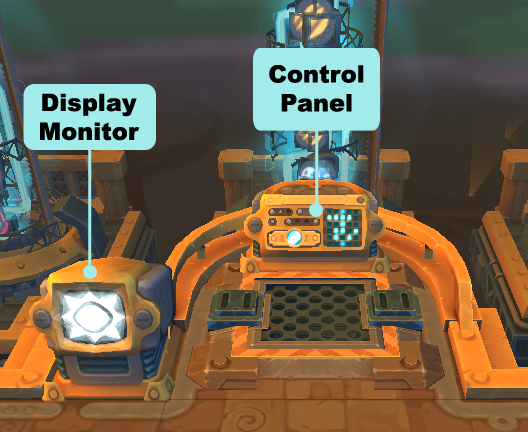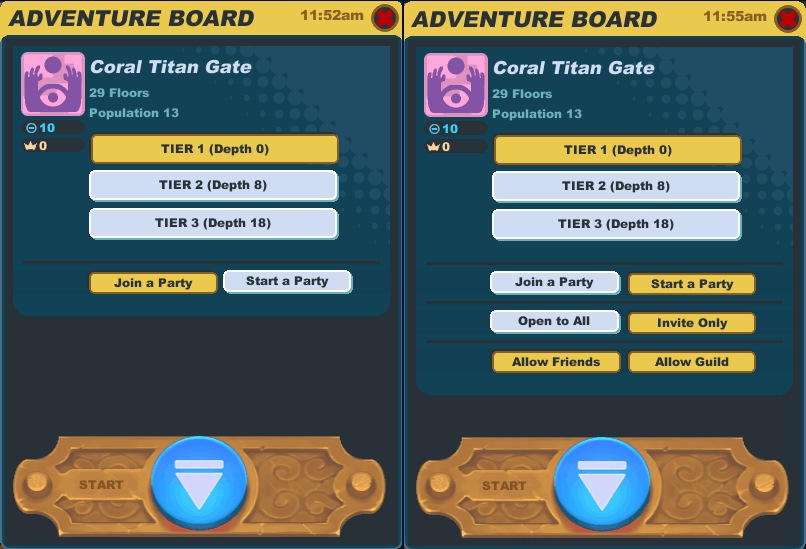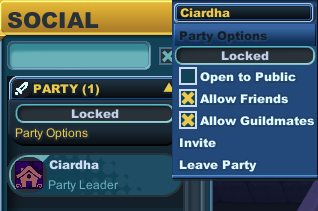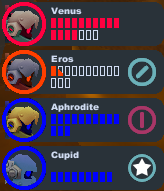Difference between revisions of "Party"
From SpiralKnights
(→Join a Party) |
m (Fixed typo) |
||
| Line 25: | Line 25: | ||
If a friend or guildmate is in a party that allows friends or guild members and has available space, then you will be able to click on that knight's name in your social panel and select "Join" to be in the same party. If you do not have tier clearance for that tier, you will need an invitation to the party as the "Join" option will not be available. | If a friend or guildmate is in a party that allows friends or guild members and has available space, then you will be able to click on that knight's name in your social panel and select "Join" to be in the same party. If you do not have tier clearance for that tier, you will need an invitation to the party as the "Join" option will not be available. | ||
| − | Parties are automatically locked from having new knights join the party when the party is in a [[Treasure Vault]] or an end boss ([[Royal Jelly]], [[Snarbolax]], [[ | + | Parties are automatically locked from having new knights join the party when the party is in a [[Treasure Vault]] or an end boss ([[Royal Jelly]], [[Snarbolax]], [[Roarmulus Twins]] or [[Lord Vanaduke]]) level. |
=== Start a Party === | === Start a Party === | ||
Revision as of 19:41, 12 March 2012
A party is a group of 1-4 knights adventuring in a gate.
There is relatively little to no penalty for traveling in a party. Everyone will receive the same amount of crowns and heat as if they were traveling solo. Knights can revive a fallen player by sharing half their health, making reviving cheaper. However, the materials found will be randomly split among party members. Monsters will also be more difficult to take down and become more durable to hits from players when the party is larger.
Parties are automatically locked from having new knights join the party when the party is in a Treasure Vault or an end boss (Royal Jelly, Roarmulus Twins, Snarbolax, or Lord Vanaduke) level.
While in the Clockworks, chat defaults to /party, allowing communication with everyone in the party, regardless of distance.
Contents
Starting or Joining a Party
Knights can start or join a party by going to an active gate in the Arcade, standing in front of the control panel and using their "Attack" button. They will have to choose what tier to start in. Some tiers will be grayed out if the Spiral Warden does not deem you experienced enough to travel to that tier.
If your knight has not played from Haven down to Moorcroft Manor or from Moorcroft Manor to Emberlight for that particular gate, you will need to pay a traveling fee to start or join a party in lower tiers. It costs 200 crowns to start in Moorcroft Manor, and 500 crowns to start in Emberlight. Starting in the party lobby is always free. You can check whether you need to pay traveling fees for specific gates and tiers by viewing the Progress tab of your Character window.
After choosing a tier, players can choose to join a party, or to create one. An option highlighted in yellow means that is the current option selected.
Knights can also join certain parties via the social menu as described in the next section.
Join a Party
If you find that you always want to start a new party when one is not available to join, you can uncheck the box in the Prompts tab of your options.
If a friend or guildmate is in a party that allows friends or guild members and has available space, then you will be able to click on that knight's name in your social panel and select "Join" to be in the same party. If you do not have tier clearance for that tier, you will need an invitation to the party as the "Join" option will not be available.
Parties are automatically locked from having new knights join the party when the party is in a Treasure Vault or an end boss (Royal Jelly, Snarbolax, Roarmulus Twins or Lord Vanaduke) level.
Start a Party
Create a party according to your specifications. These include:
- Open to All: Choose this if you are not picky about who joins your party, or have it "invite only".
- Invite Only: If this is selected, then you have more options to choose from. You can restrict it only to friends, guild members, or both. If you wish to travel solo, make sure the "allow friends" and "allow guild" options are not yellow.
Equipment Locking
While you are in a party down in the Clockworks, you will not be able to change your equipment unless you are in the Clockworks Party Lobby, Clockwork Terminal, or using an Arsenal Station. A message will be seen at the top of the character window whenever your equipment is locked due to this.
Inviting and Booting Members
Depending on the party settings, members can invite other players to join the party. Party members cannot invite another person if the party is full or if the party leader locked the party. In that case, only the party leader can invite other players (up to a maximum of four members in a group). Knights that do not have clearance for that tier will need an invitation to join. Invitations cannot be sent while in a Treasure Vault or an end boss (Royal Jelly or Lord Vanaduke) level.
Only the party leader can boot members from its group. If a group member is violating the Terms of Service or Community Standards, file a complaint and boot the player.
Going Solo
At any time, while in the Clockworks, a knight may choose to separate from a party. Simply open the party menu and choose "Go Solo". Choosing to adventure alone will bring a knight to a new instance of the Gate in the same spot where "Go Solo" was selected and in the same state of completion (party buttons triggered will remain so). Remember that there are some draw-backs to going solo: any heat or crowns collected on that depth so far and items on still the ground will be erased.
Party Members Menu
Each knight in the party will appear in the party menu list in the top left corner of the screen displaying a knight's health below their name and energy status to the right. There is no energy icon for your own knight. Energy status will show a horizontal line (-) for knights with normal energy, a five pointed star for knights that are on your tab, a slash (/) for knights who are being paid on another knights tab, and a vertical line (|) for knights who are low on energy. To pay for another knight's energy, click their energy icon and choose to add them to your tab (|), either for elevators only or everything (including elevators, revives, danger rooms, and other energy costs). You can also click on a knight's paid (star) icon and use the menu to stop paying for their energy costs or switch which type of costs you are paying for.
Picking up Objects
Spiral Knights is designed to be a cooperative game. For most objects found in the Clockworks, party members do not compete, but rather collaborate, in picking them up.
When a knight picks up a crown or token, everyone in the party immediately gets that crown or token. A knight who tediously smashes plants in search of hidden crowns is doing his fellow knights a favor, as long as he doesn't delay the party too much. Each crown or token gained is applied immediately; even if a knight doesn't finish the level, he still keeps the crown or token.
When a knight picks up a heat ember, everyone in the party immediately gets that heat. Unlike crowns and tokens, heat is not immediately applied. When a knight dies he loses 30% of his heat gained thus far on that level, and when he revives a fallen knight using health he gets that knight's lost heat. So there is an incentive for players to play with skill, and to revive their party members using health. A knight keeps the heat that he has gained on a level only if he completes the level (by reaching a lift and using it to go down or up). At that time, an animation appears showing the heat's being applied to the knight's equipment.
Each party member may carry one mineral at a time. Like heat, minerals are applied to the knight only when the level is completed. When the lift goes down (or up), every knight gets to see every other knight's collected minerals and/or materials.
When a knight picks up a crafting material, that material is randomly given to a single party member, which is often not the knight who picked up the material. Even a knight who is lying on the ground may acquire materials as his fellow knights pick them up.
When a healing heart appears, that heart exists separately for each knight. When a knight picks up the heart, it disappears from his or her display, but remains on the displays of the other knights until they pick it up.
In contrast, when a vitapod or pickup (healing pill, vial, etc.) appears, there is only one copy of that object. The first knight to pick it up gets it, and the other knights do not get it. On rare occasions, a treasure box or monster will drop an actual item, such as a Heart Pendant. In this case, the drop will randomly go to a knight in the party, without regard to whoever picked up the drop.
In short, there is no reason for party members to compete for crowns, tokens, heat, minerals, materials, or hearts. The party should simply ensure that every one is picked up. The only objects for which knights compete are vitapods, pickups, and items. Often party members share pickups, for the good of the party.
Single vs. Multi-Player Parties
When there are multiple knights in a party, the monsters faced are somewhat more difficult. Each party member adds to every monster's health, whether it be Lord Vanaduke or a lowly jelly cube. In a Graveyard there is always one Phantom per knight.
Knights traveling together can benefit from teamwork:
- Knights can revive fallen comrades using half of their health. The fallen knight spends no energy, and the reviving knight is rewarded in heat.
- As long as (at least) one knight makes it through the level to the lift, the entire party makes it through the level. If the surviving knight goes down at the lift, then all party members (with sufficient energy) go down. The fallen party members do not gain heat from the level, but do start the next level with three bars of health.
- There are various tactical advantages. For example, a knight can free a comrade trapped in a block of ice, and one knight can lure a monster while another knight attacks it from behind. By having multiple knights, the party can in aggregate have a more varied assortment of weapons. For example, the party can have swords dealing multiple kinds of damage, guns dealing multiple status effects, etc. Although monsters have more health in multi-player adventures, the damage from multiple knights easily outweighs that extra health.
- Generous knights can help pay for their comrades' elevator trips and other energy costs.
- More knights in a party means more minerals picked up, and hence more money for everyone from minerals.
Some players prefer to travel alone. Because materials are randomly distributed among the party members, a knight will get all of the materials dropped only when he is traveling solo. On the rare occasions when an item appears, the solo knight is guaranteed to get the item.
